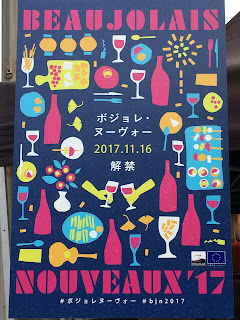Around this time of the year - the third Thursday in November to be precise - Japan goes mad for the new batch of Beaujolais Nouveau, with lots of promotions in supermarkets (pictured below). This year imports are expected to reach almost six million bottles, double the US figures. Just north of Omotesando I spotted an outdoor drinking spot which had specially been set up so people could start drinking at 12:01 on Friday morning. Since last year, one gimmick promoted by various
onsen (hot springs) has been to pour the red stuff into the communal bath (see video
here)! In recent years though, despite the best efforts of the companies and businesses concerned, Japanese have begun to lose interest in the red Gamay wine. This year looks to be the
fifth consecutive year that sales and imports have fallen. The peak was in 2004. Part of the reason has ironically been the growing availability of good cheap wines which has resulted in the pricey Beaujolais Nouveau no longer being seen as particularly special - or tasty - any more.
 |
| Shōchū-haibōru or chū-hai alco-pops |
So what do the Japanese drink? Well, the first thing to note is that "sake" (酒) in Japanese denotes alcohol in general - the "rice-wine" we refer to as "sake" in English is called
nihon-shu (日本酒) in Japan. Although well-known in the West it is actually less popular than
shōchū (焼酎), a spirit originally from Kyushu distilled from barley, sweet potatoes, or rice which is also drunk straight like
nihon-shu. In particular,
shōchū-haibōru (highball), better known as
chū-hai - a sweet "alco-pop" type
shōchū cocktail - has become very popular in recent years, especially amongst young women (confusingly categorised under "liqueur" in the pie-charts below). Nevertheless, the most popular tipple remains beer (ビール), though in recent years sales have plummeted, despite the appearance of cheaper "beer-like" drinks such as
happōshu (発泡酒)(low-malt beer) and zero-malt
dai-san bīru (third-category beer). The pie charts below show the shift in alcohol sales between 1989 and 2015 based on this year's National Tax Agency report (available
here).
 |
| Click to preview |

The drinking age in Japan is 20 in Japan but few establishments bother asking for IDs. In fact, people in their twenties drink very little in Japan; however, alcohol consumption jumps dramatically once Japanese reach their thirties. The drinking peak for men is in their sixties and for women in their forties; at these ages 58% of males and 25% of females are regular drinkers - meaning they drink three or more times a week. Moreover, drinking in public is widely tolerated, anything from a can of beer on the train to a jar of "one-cup" cheap sake drunk outside the convenience store. Being drunk in public is widely tolerated too, and plenty of places have
nomihodai all-you-can-drink menus (usually with a two-hour time limit) not to mention all the beer vending machines. As a result, the sight of drunken office workers weaving around, falling over, and even vomiting in alleyways is not uncommon, especially on Friday and Saturday nights - as well as
bonenkai (忘年会) end-of-year (literally "forget-the-year") party season. The nice thing though is the almost complete absence of violence - unlike in Britain where town-centres become something of a war-zone at pub closing time.



 The drinking age in Japan is 20 in Japan but few establishments bother asking for IDs. In fact, people in their twenties drink very little in Japan; however, alcohol consumption jumps dramatically once Japanese reach their thirties. The drinking peak for men is in their sixties and for women in their forties; at these ages 58% of males and 25% of females are regular drinkers - meaning they drink three or more times a week. Moreover, drinking in public is widely tolerated, anything from a can of beer on the train to a jar of "one-cup" cheap sake drunk outside the convenience store. Being drunk in public is widely tolerated too, and plenty of places have nomihodai all-you-can-drink menus (usually with a two-hour time limit) not to mention all the beer vending machines. As a result, the sight of drunken office workers weaving around, falling over, and even vomiting in alleyways is not uncommon, especially on Friday and Saturday nights - as well as bonenkai (忘年会) end-of-year (literally "forget-the-year") party season. The nice thing though is the almost complete absence of violence - unlike in Britain where town-centres become something of a war-zone at pub closing time.
The drinking age in Japan is 20 in Japan but few establishments bother asking for IDs. In fact, people in their twenties drink very little in Japan; however, alcohol consumption jumps dramatically once Japanese reach their thirties. The drinking peak for men is in their sixties and for women in their forties; at these ages 58% of males and 25% of females are regular drinkers - meaning they drink three or more times a week. Moreover, drinking in public is widely tolerated, anything from a can of beer on the train to a jar of "one-cup" cheap sake drunk outside the convenience store. Being drunk in public is widely tolerated too, and plenty of places have nomihodai all-you-can-drink menus (usually with a two-hour time limit) not to mention all the beer vending machines. As a result, the sight of drunken office workers weaving around, falling over, and even vomiting in alleyways is not uncommon, especially on Friday and Saturday nights - as well as bonenkai (忘年会) end-of-year (literally "forget-the-year") party season. The nice thing though is the almost complete absence of violence - unlike in Britain where town-centres become something of a war-zone at pub closing time.

